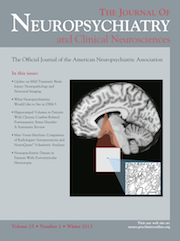Is Attention a “Period Window” in the Chaotic Brain?
To the Editor: Artificial neural networks (ANNs), introduced in the fields of mathematics and engineering, are inspired from biological neural networks. They have abilities like those of the neural network system of the human. Among these abilities, the most important one is ability in learning and generalization. Therefore, the ANNs have become implemented in a variety of fields, such as pattern recognition, classification, and control.1
Some researchers have shown that brain signals (EEGs) have deterministic, chaotic properties.2 In order to make ANNs more similar to the real nervous system (and thus taking more advantages of its abilities), chaotic neural networks were introduced.3 It was observed in more recent research that, during attention, EEG signals are nearly periodic and more ordered, as compared with the resting state, in which brain behavior is more chaotic.4 However, there is no model that includes this phenomenon.
On the other hand, almost all of the chaotic systems have some parameters in which specific changes in their values may affect the behavior of the system, not only quantitatively, but also qualitatively. In other words, changing the values of these parameters may cause the system to bifurcate. Some chaotic systems have an interesting characteristic: the system suddenly shows periodic behavior when it is in chaotic mode. These periodic behaviors belong to small regions called “period windows” that are embedded in the chaotic region of the bifurcation diagram of the system.5
We propose that the periodic behavior during attention could be period windows embedded in the chaotic brain. Hence, designing chaotic ANNs and creating periodic windows in them may help neuroscientists in studying attention, and, specifically, the learning that occurs during attention. Such models will probably be applicable in diagnosing attention disorders. Surely, experimental researches are needed to validate such ANNs.
1 : Introduction to Neural Networks. Cambridge, MA, MIT Press, 1995Google Scholar
2 : Strange attractors that govern mammalian brain dynamics shown by trajectories of electroencephalographic (EEG) potential. IEEE Trans Circ Syst 1998; 35:781–783Crossref, Google Scholar
3 : Interactions between neural networks: a mechanism for tuning chaos and oscillations. Cogn Neurodyn 2007; 1:185–188Crossref, Medline, Google Scholar
4 : The Physiology of Perception. Sci Am 1991; 264:78–85Crossref, Medline, Google Scholar
5 : Chaos and Nonlinear Dynamics: An Introduction for Scientists and Engineers, 2nd Edition. London, UK, Oxford University Press, 2001Google Scholar



